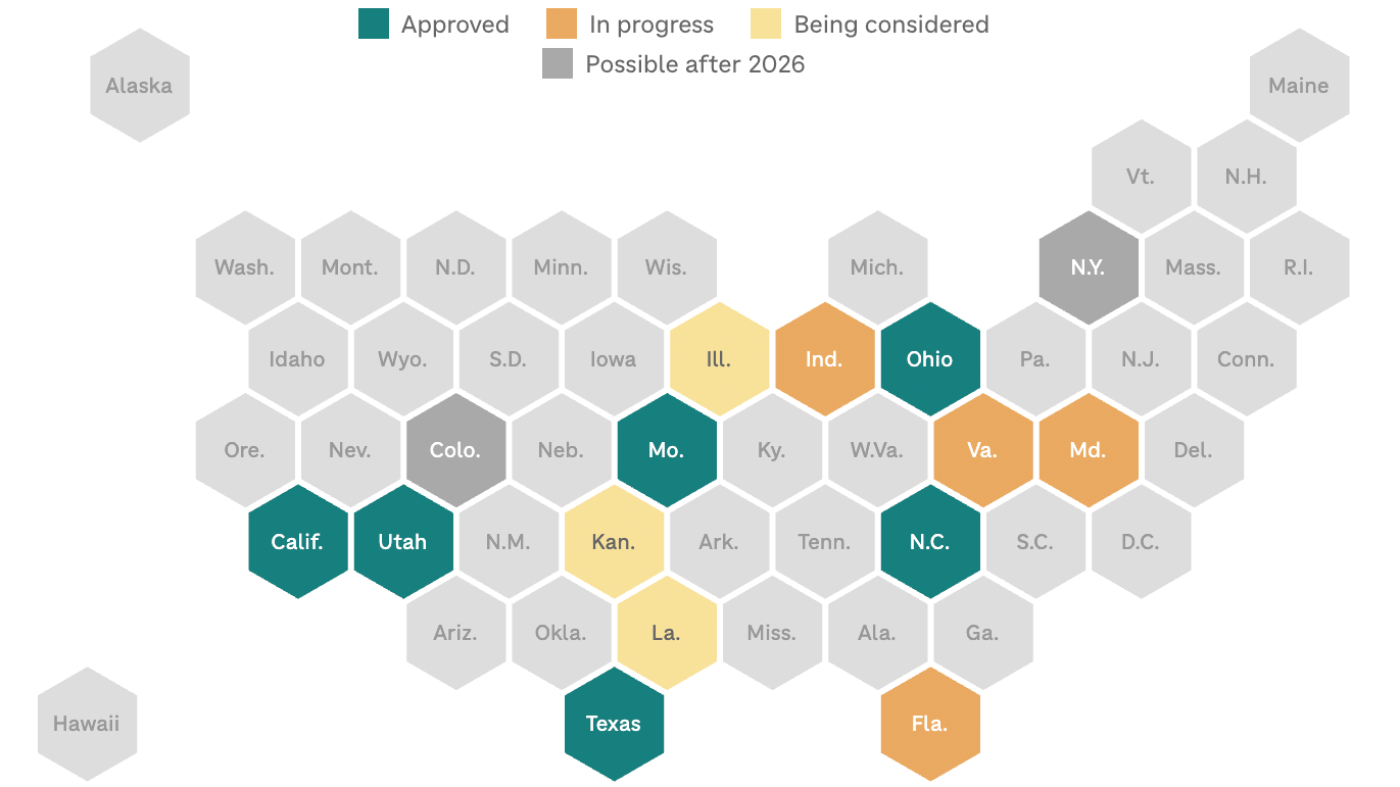Lifestyle
L.A. Times Concierge: My 73-year-old mom is visiting from the East Coast. Where should I take her?

My 73-year-old mother is coming to visit from the East Coast. She recently had hip surgery and it’s painful for her to walk too far. She likes quirky experiences like sushi on conveyor belts. I live in Sawtelle. Other times she has come we have gone to the Getty Villa, a couple studio tours, live taping of “Jeopardy!” and a local ramen place. She likes places with a backstory. For example in Boulder, she wanted to drive past the house where JonBenét Ramsey had lived because she is obsessed with true crime. One thing she did say she wanted to do was try to see “Jimmy Kimmel Live!” — CJ Schellack
Here’s what we suggest:
First off, your mom sounds like a good time. And I agree with her: The best places to visit often have an interesting backstory. Let’s start with the food. Given that your mom likes sushi experiences, make a stop at Yama Sushi Marketplace, conveniently located in your neighborhood. The family-owned Japanese seafood shop sells restaurant-quality sushi at takeout prices, writes Tiffany Tse in our guide to Sawtelle. “Just point to what catches your eye, and the staff will slice it fresh, sashimi-style, right in front of you,” she adds. Or if you’d prefer to check out another revolving sushi spot, check out Kura, which has a Sawtelle location.
To satisfy your mom’s appetite for one-of-a-kind, quirky experiences, head to Galco’s Soda Pop Stop in Highland Park. Yes, it’s a bit of a push from your hood — don’t go during rush hour — but it’s worth the trek, especially if you have a sweet tooth. The 100-year-old family-owned shop is stacked with aisles of rare sodas from around the globe, nostalgic candies and retro toys that its 82-year-old owner John Nese tells me “you can’t find anywhere else.” In the back of the shop, next to the make-your-own-soda station, there’s a deli stand that sells “blockbuster” sandwiches — a name that was inspired by boxing legend Rocky Marciano who, after tasting one, declared “This is a real blockbuster!” (Pro tip: If Nese is there when you visit — and the likelihood is high because he “practically lives there,” he says — be sure to ask him for a rec.)
Once you’ve secured your snacks, grab a picnic blanket or low chair and head over to Hollywood Forever Cemetery to watch a movie — a favorite L.A. experience for many of my colleagues. Through Halloween, Cinespia is hosting movie nights at the cemetery where stars like Judy Garland, Mickey Rooney and Johnny Ramone are laid to rest. Films are projected onto a mausoleum wall and moviegoers sit on the lawn (an open area with no graves). There’s a designated wheelchair user and companion area with restrooms close by, and accessible parking is available with a placard (though you’ll still need to buy a parking pass in advance).
But if you think your mom would be more comfortable indoors, check out the Quentin Tarantino-owned New Beverly Cinema, known for screening double features of classic, indie, cult and foreign flicks the old-fashioned way — on 35mm film. As Michael Ordoña writes in our guide to the best movie theaters in Los Angeles, “the New Bev is just what a rep cinema should be. It’s cozy, with a mellow, enthusiastic vibe. Surprises sometimes occur.”
To tap into your mom’s inner true crime fascination, make a visit to some of L.A.’s darker landmarks. “I like to take friends visiting from the East Coast on a drive along the Sunset Strip to show them where famous people died, like Belushi at Chateau Marmont and River Phoenix outside the Viper Room,” senior audience editor Vanessa Franko tells me. (Bonus: You don’t even need to get out of your car.) But if you prefer an actual tour, visit the Greystone Mansion and Gardens, where oil heir and homeowner Ned Doheny and his secretary, Hugh Plunkett, were found dead in 1929. Times travel writer Christopher Reynolds recommends it, saying that at this destination, you get “a crime scene, filming location and L.A. oil history, all in one.” We’ve also curated a list of 12 iconic L.A. film and TV horror homes that’s worth checking out (the filming location for the WB series “Charmed” is featured in the photo illustration above). I hope that you and your very cool mom have the best time. Please send us pictures if you hit up any of these spots.

Lifestyle
Here are the 2026 Golden Globe nominations

Here are the 2026 Golden Globe nominations Marlon Wayans and Skye P. Marshall presented the nominees for the 83rd Golden Globes this morning. The awards ceremony will be held on Jan. 11, hosted by Nikki Glaser.
YouTube Marlon Wayans and Skye P. Marshall presented the nominees for the 83rd Golden Globes this morning. You can watch the announcement above.
The Golden Globes awards ceremony will be held on Jan. 11, hosted by Nikki Glaser.

Lifestyle
What Should a 21st Century Mechanical Watch Look Like?

Lifestyle
Sunday Puzzle: Swapped first and last letters

On-air challenge
I’m going to give give you clues for two words. Switch the first and last letters of the answer to the first clue to get the answer to the second. (Ex. Nutmeg or ginger / Long, heroic poems –> SPICE & EPICS)
1. Make a grand speech / Muse of love poetry
2. What a skull and crossbones signifies / Wandered around
3. Words to a song / Saint for whom the Russian alphabet is named
4. Yell / Amounts equal to ten $100 bills
5. Assignments for delivery drivers / Former Supreme Court Justice David ______
6. Small bag with a shoulder strap / Some gate fasteners
Last week’s challenge
Last week’s challenge came from Al Gori, of Cozy Lake, N.J. Name a place where games are played. Move the last two letters to the beginning. Change the new last letter to an “H.” The result, sadly, is what you might have when you leave this place.
Challenge answer
Casino, no cash
Winner
Mike Rombach of Pleasanton, California.
This week’s challenge
This week’s challenge comes from Mike Reiss, who’s a showrunner, writer, and producer for “The Simpsons.” Think of a famous living singer. The last two letters of his first name and the first two letters of his last name spell a bird. Change the first letter of the singer’s first name. Then the first three letters of that first name and the last five letters of his last name together spell another bird. What singer is this?
If you know the answer to the challenge, submit it below by Thursday, December 11 at 3 p.m. ET. Listeners whose answers are selected win a chance to play the on-air puzzle.
-

 Alaska2 days ago
Alaska2 days agoHowling Mat-Su winds leave thousands without power
-
Ohio4 days ago
Who do the Ohio State Buckeyes hire as the next offensive coordinator?
-

 Politics6 days ago
Politics6 days agoTrump rips Somali community as federal agents reportedly eye Minnesota enforcement sweep
-

 News6 days ago
News6 days agoTrump threatens strikes on any country he claims makes drugs for US
-

 World6 days ago
World6 days agoHonduras election council member accuses colleague of ‘intimidation’
-

 Texas2 days ago
Texas2 days agoTexas Tech football vs BYU live updates, start time, TV channel for Big 12 title
-

 Politics6 days ago
Politics6 days agoTrump highlights comments by ‘Obama sycophant’ Eric Holder, continues pressing Senate GOP to nix filibuster
-

 Politics1 week ago
Politics1 week agoWar Sec Pete Hegseth shares meme of children’s book character firing on narco terrorist drug boat
















